DESIGN
Solution -Alerts and Insights Dashboard
To help sales managers better understand seller-buyer communication, we designed a dashboard with an "inbox zero" email approach and alerting system. This allows managers to quickly address, snooze, or archive alerts and insights on issues, meetings, and rep performance metrics in a centralized view.
Mapping Out Alerts
In collaboration with Novacy's CPO, we mapped out 60 different types of alerts and trends that can occur during a deal's lifecycle, covering verbal, non-verbal, and other interactions.
We categorized alerts into three main types - Seller Alert, Seller Trend, and Team Trend - to provide sales managers a comprehensive view of potential issues, whether triggered by a single occurrence or emerging patterns.
The alerts are designed to flag significant non-verbal cues, verbal indicators, and other deal-related activities that may require the manager's attention, allowing them to proactively address concerns with their sales team.
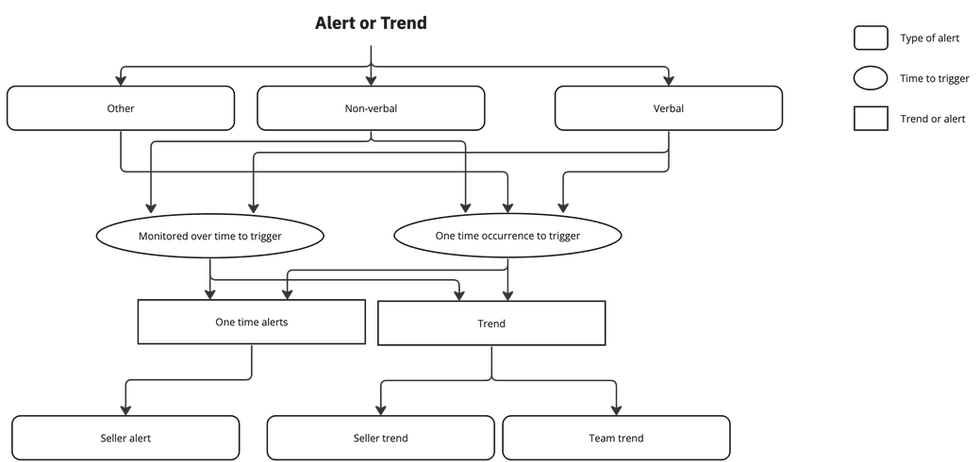
Flowchart determining the type of alert
For each alert, we defined its meaning, trigger, user-facing explanation, and edge cases. For example, the "Stuck Deal" alert would trigger if a deal didn't progress in probability to 'closed won' in the CRM for a set number of days. The edge case would be to not trigger the alert if the decision-makers were all marked as out-of-office during that time period.
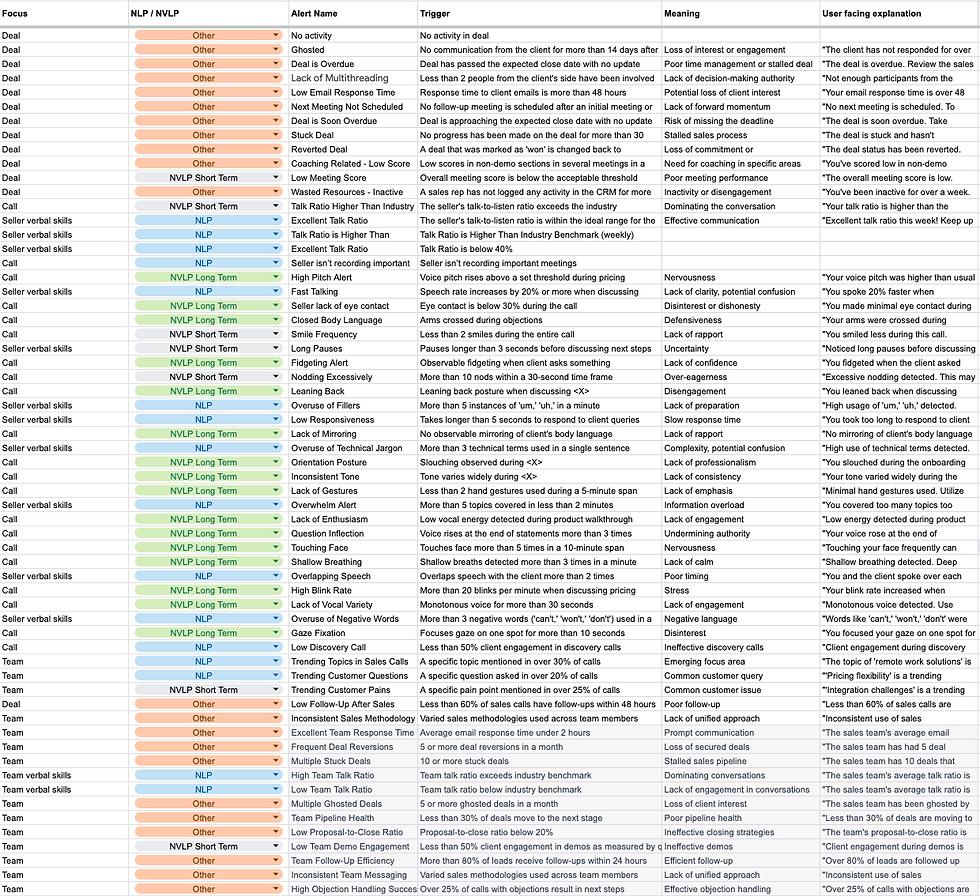
Complete list of categorized alerts
Narrowing Down the Alerts for MVP
Due to the fact that the alerts are based on detecting actions and behaviors (or lack of), we needed to make sure together with the CTO which alerts are technically possible to achieve for the MVP, and which can be rolled out at later dates.

Narrowed down list of categorized alerts
Low Fidelity Wireframes
It's important to note that since this project was meant to be added to an existing product, some components were taken from the existing design system (such as the dropdown field and the tables), which is why some parts of the low-fidelity designs are more complete than other components that are not part of the design system (cards and alerts).
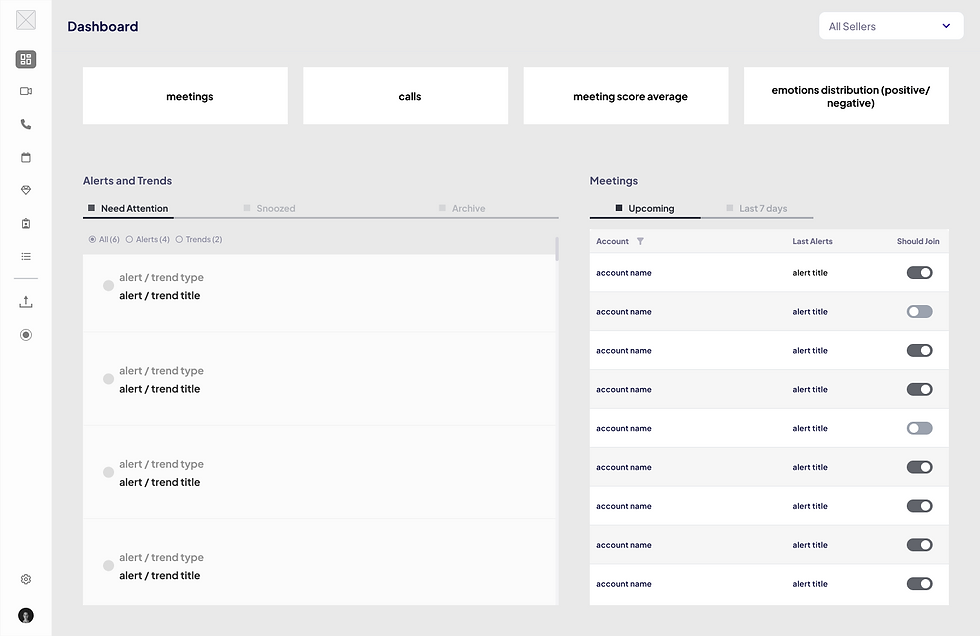
Home
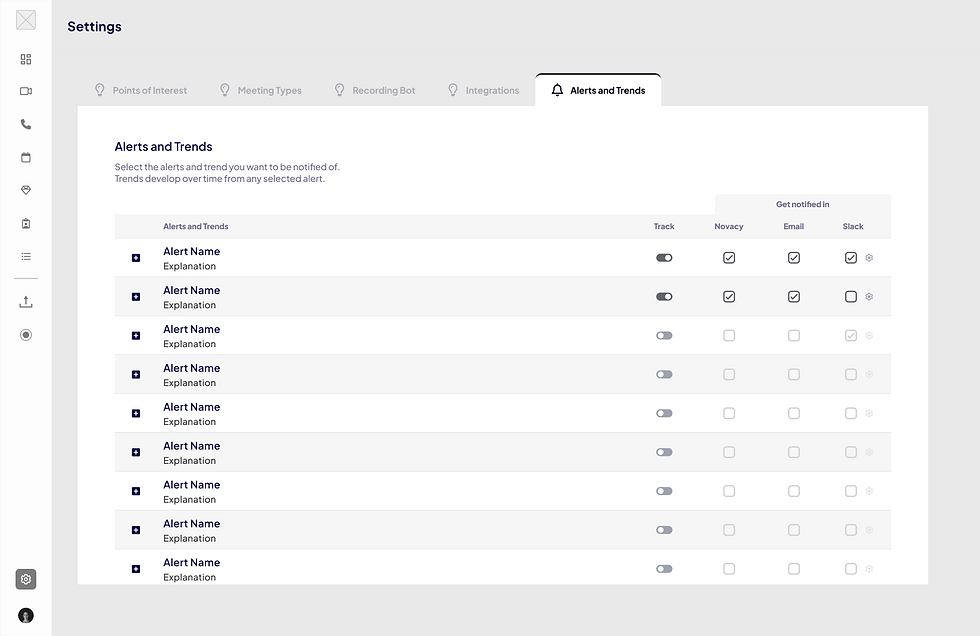
Settings
Alerts and Trends States
Based on the list of alerts and trends we'd created, we were able to further categorize them into two main groups - positive and negative, which is visualized using a red or green line on the side of the alert/trend card.
Regardless of the alert or trend itself, when thinking about the management of notifications of this kind, there are several things to note:
-
An alert/trend can happen several times. Before an alert becomes a trend, it can be triggered more than once. For example, if an alert only becomes a trend after 15 occurrences, but the action has occurred 12 times - the manager will be notified of this with a 'Repeated Alert' label to make him aware of that.
-
An alert/trend can be snoozed to allow the manager to be reminded of it at a later time.
-
An alert/trend needs to be able to be marked as completed to allow the manager to clear their inbox.
.png)
States and variants of an alert/trend
ALERT TYPE
There are 9 variations of alert types, which means that the users need to know what type of alert is being presented on the screen in order to have context to the alert title and description.

EMOTION INDICATOR
Novacy analyzes interactions on 3 emotional scales: Positive, negative, and neutral.
To indicate to the manager the general notion of the alert (whether it's positive or negative), I added a colored bar on the left-hand side of the card. Red = negative, Green = Positive.

Customizable Alerts and Notifications
Because every manager won't necessarily want to be alerted about every one of the alerts we mapped out, I created a new tab in the existing settings page where the manager can manage the alerts they want to track, and if and how they want to be notified about them.
Furthermore, the manager can expand the settings of a specific alert or trend to customize its settings to make sure that they are getting notified only when it's really important. For example, the user can set a 'No Activity' alert to go off after 10 days of inactivity instead of the usual 14 days. This way, they get alerts that matter to them, when they want them.

Expanded alerts settings
As Novacy is a B2B platform, I limited the notification locations to just two professional external tools, in addition to the Novacy platform's notification center:
-
Slack - the user gets notified in a designated Slack channel.
-
Email - the user gets notified in their work email inbox.
Adding these notification options is meant to help the users incorporate this new alerting system feature into their day-to-day workflow.

Alert that is being tracked, and its notification settings
Empty States
Since this was a real-life project, I had to hand off the design to developers, which meant I had to think of edge cases and empty states.

First use

Empty inbox

No snoozed alerts or trends
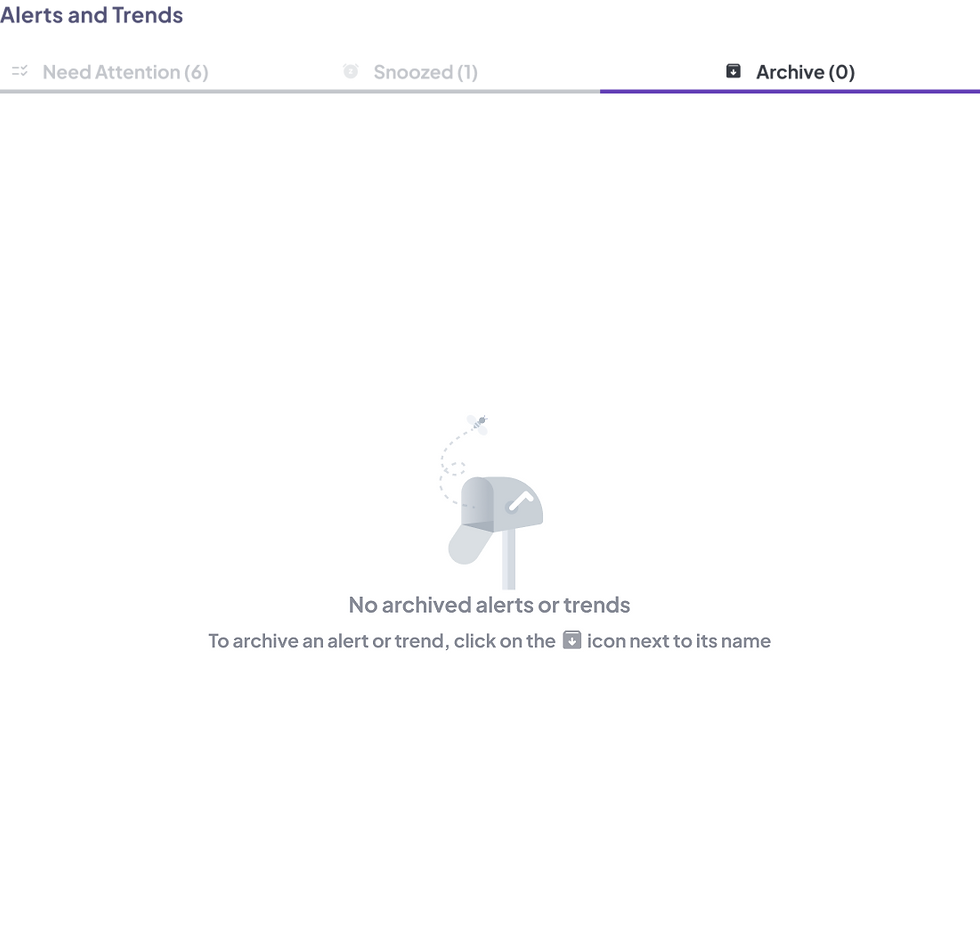
No archived alerts or trends
Final Design

Home

Settings
.png)

My Role
Sole UX/UI designer, UX research
Project
Novacy.io
Timeline
5 weeks (August-September 24')
Platform
Web desktop
About this Project
This alerts system was meant to be an additional module in the existing Novacy platform to help sales managers be aware of the progress of the deals their AEs (account executives) are managing. Within 5 weeks, I researched, ideated, and prototyped the way to a design proposal, targeting the need for sales managers to get another level of visibility into ongoing deals.
Alerts System Design
Improving the management of sales cycles through a sales oriented alerts system
About Novacy
Novacy helps B2B revenue teams gain higher success rates and more accurate predictions using audio, text, and body language analysis of virtual meetings, by understanding their prospects' underlying perceptions.
Sales managers in revenue teams typically have a range of responsibilities aimed at maximizing sales performance and revenue generation. These responsibilities include monitoring their AEs' performance and coaching them to improve. Typically, AEs record their meetings, and sales managers use Novacy to review them.
PROBLEM
Problem - Adoption Challenges
Although Novacy uncovers the extra layer of body language analysis to help understand the buyers' true feelings towards a topic discussed in a meeting, sales managers have provided us with feedback that they don't have enough time to review all of the meetings their AEs record to experience the advantages Novacy provides.
Objective
Make any crucial information to the success of a deal easily accessible, visible, and actionable to the sales manager.
RESEARCH
Interviewing 5 Sales Mangers
Interviews were conducted with 5 sales managers from B2B tech companies, to understand what information is important for sales managers to know about their AEs and the deals they're managing.
Findings
1. The managers overall knew what kind of verbal insights they wanted to be aware of, such as talking about competitors, use of negative sentiment by the seller towards their own company, etc.
2. The managers didn't know exactly what information they were looking for when it came to non-verbal insights but knew they wanted to be aware of anything that might put the deal at risk.
3. The managers wanted to understand if an issue is recurring in the team or with a specific seller, so they know what to work and coach them on.
DEFINE
Persona
Daniel Mansour
43 | Sales Manager | Tel Aviv, Israel
Daniel manages a team of 10 AEs. He wants to review their meetings and help them improve and close more deals but with all of his other responsibilities, he can only find the time to review specific meetings his AEs ask for his help with.
Daniel manages a team of 10 AEs. He wants to review their meetings and help them improve and close more deals but with all of his other responsibilities, he can only find the time to review specific meetings his AEs ask for his help with.
NEEDS
-
Insights from meetings to be provided to him
-
Understand what the team or individual seller needs to improve on.
FRUSTRATIONS
-
Not enough time to understand which deals need help with unless the AE asks for help
-
When he has time to review meetings, he doesn't know which ones need his attention